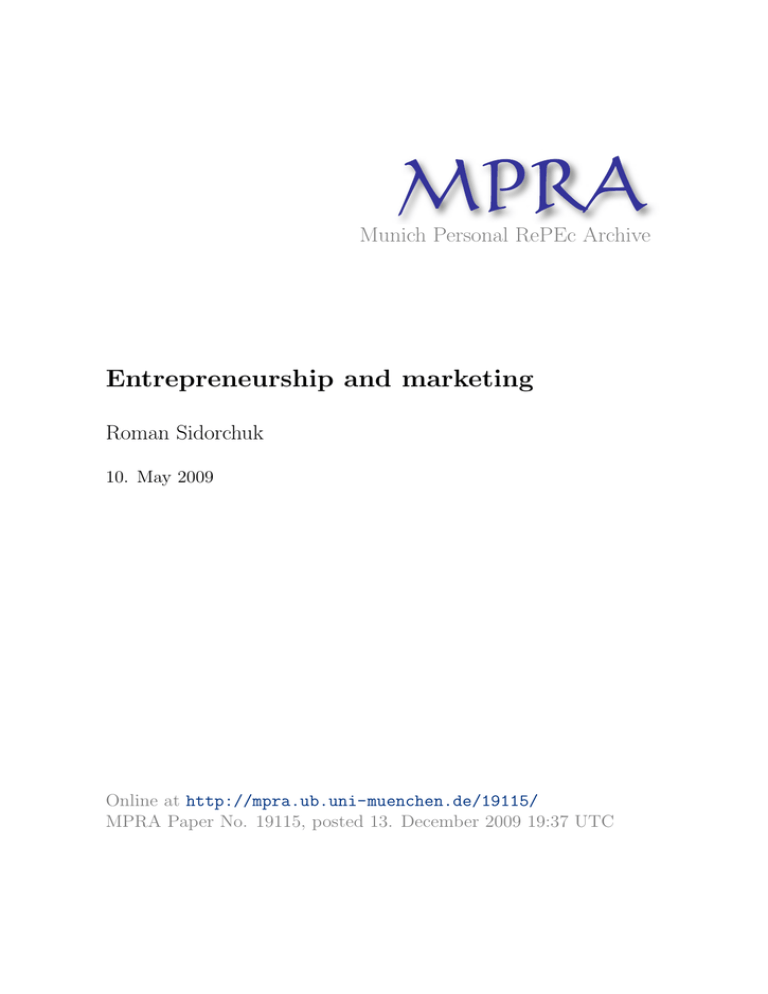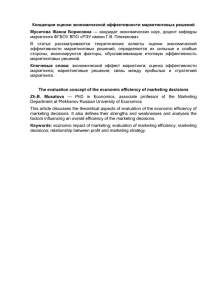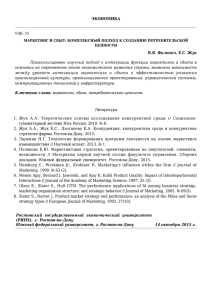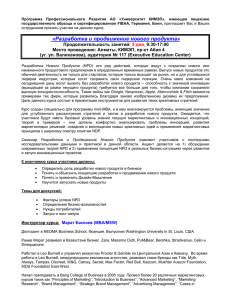Entrepreneurship and marketing - Munich Personal RePEc Archive
advertisement

M PRA
Munich Personal RePEc Archive
Entrepreneurship and marketing
Roman Sidorchuk
10. May 2009
Online at http://mpra.ub.uni-muenchen.de/19115/
MPRA Paper No. 19115, posted 13. December 2009 19:37 UTC
Предпринимательство и маркетинг
Р. Р. Сидорчук, к.э.н., консалтинговая компания «RSconsult», доцент кафедры
маркетинга Российской экономической академии имени Г.В. Плеханова
Сайт www.rsconsult.ru
Эл. почта r.sidorchuk@rsconsult.ru
Тел. (495) 223-11-54
Entrepreneurship and marketing1
R. Sidorchuk, PhD, the senior lecturer of chair of marketing Russian Economical Plehanov's
Academy, the adviser of company "RSconsult"
Резюме автора
В 1991 г. закончил МЭИ, затем в течении 12 лет занимал руководящие посты на
предприятиях оптовой и розничной торговли (компьютеры, промышленное
оборудование, продукты питания), в 2001 г. закончил Магистратуру в РЭА им Г.В.
Плеханова, в 2004 г. защитил кандидатскую диссертацию в РЭА им Г.В.
Плеханова, последние три года работает в консалтинговом бизнесе и преподает
маркетинг в РЭА им. Г.В. Плеханова.
The resume of the author
In 1991 has finished Moscow Power Engineering Institute , then in a current of 12 years held
supervising posts at the enterprises wholesale and retail trade (computers, an industrial
equipment, a foodstuff), in 2001 has finished the Magistracy in Russian Economical Plehanov's
Academy, in 2004 has protected the PhD thesis in Russian Economical Plehanov's Academy,
works last three years in consulting business and also teaches marketing Russian Economical
Plehanov's Academy.
Аннотация
Статья посвящена анализу взаимосвязи маркетинга и предпринимательства. Маркетинг
рассмотрен как неотъемлемая часть предпринимательской деятельности.
Выделена роль маркетинга во взаимосвязи предпринимательства и внедрении инноваций.
Показана роль маркетинга, в поиске потенциально востребованных рынком инноваций
как сферы латентных или неудовлетворенных потребностях покупателей.
отсутствие в современном маркетинге специального
Показано
маркетингового инструментария
для предпринимателей.
1
Translated into English with the help translate google http://translate.google.com/#
1
Abstract
This article analyzes the relationship marketing and entrepreneurship. Marketing considered as
an integral part of entrepreneurship. Commit role in relationship marketing and
entrepreneurship innovation. The role of marketing in the search for potential market demand of
innovation as the scope of latent or unmet needs of customers. Shown the lack of marketing in
today's special marketing tools for entrepreneurs.
Ключевые слова:
маркетинг и предпринимательство, инструменты маркетинга, маркетинг в малом бизнесе,
маркетинг и инновации, маркетинг и рост бизнеса, маркетинг для предпринимателя
Keywords:
marketing and entrepreneurship, marketing tools and marketing in small business, marketing
and innovation, marketing and business growth, marketing for the entrepreneur
Маркетинг и предпринимательство традиционно рассматривают как две отдельные
академические дисциплины, хотя существуют научные школы, объединяющие их вместе.
Изучение взаимосвязи между этими дисциплинами является важным шагом для решения
практических задач в предпринимательской практике
Развитие теории предпринимательства
Несмотря на длительную историю изучения предпринимательства [33, стр. 106120] первая последовательная теория была предложена относительно недавно. Эта теория
была предложена австрийским экономистом Й. Шумпетером [35], что отметили в своих
работах К. Фримен[11, стр. 17-38.] и П. Друкер. [10].
Й.
Шумпетер
предложил
гипотезу,
согласно
которой
основой
процесса
экономического развития является предпринимательская деятельность. Другим важным
элементом, отмеченным Й.Шумпетером, является понятие инновации, которое он
определил очень ёмко, и куда помимо технических инноваций включил все виды
нововведений (организационные, управленческие, рыночные и др.). По
Й.Шумпетеру
предприниматель - это не должность или специальность, это особая, уникальная
способность
выявлять
Соответственно,
конкурентную
и
организовывать
предприниматель
реструктуризацию
-
это
продвижение
новатор,
экономики
и
инноваций
обеспечивающий
экономический
рост.
на
рынок.
постоянную
Однако
в
2
исследованиях Й. Шумпетера без ответа остается вопрос: за счет, каких знаний, интуиции
и таланта предпринимателю удается определить сферу успешных инноваций? Также
немаловажным является вопрос:
можно ли научиться выявлять и организовывать
продвижение инноваций, которые будут востребованы?
Интересным продолжением в развитие теории предпринимательства Й. Шомпетера
стали статистические исследования динамики роста малых компаний Д. Бёрча [2].
В середине 70-х годов Д. Бёрч приступил к исследованию влияния перемещения
компаний из штата в штат на уровень занятости. В своих исследованиях Д. Бёрч
использовал картотеку оценки кредитоспособности Дана и Брэдстрита (credit rating files of
Dun and Bradstreet) [33, стр. 106-120]. В этой базе данных фиксировались основные
характеристики каждой компании в некотором базовом году и прослеживались ее
местоположение и размер на протяжении последующих восьми лет. Д. Бёрч фиксировал
размерный класс, к которому принадлежала та или иная компания в базовый год, а затем
все изменения уровня занятости в компании в последующие годы независимо от того, в
какие классы данная компания потом реально переходила. В результате использования
этого метода было установлено, что за исследованный период с 1969 по 1976 г. 82% вновь
образованных рабочих мест были созданы малыми компаниями. ( К категории малых он
отнес компании с числом работников менее ста.)
Дальнейшие
исследования
[3]
показали, что большинство новых рабочих мест в действительности создается
относительно небольшой горсткой быстрорастущих компаний - не обязательно малых,
хотя
малые
среди
них представлены
значительно
шире
других.
Эта
группа
быстрорастущих компаний, составляющая не более 3% всего бизнеса США, была названа
“газелями". Две другие группы по классификации Д. Бёрча представляют мелкие
компании - “мыши" и крупные стагнирующие компании - “слоны".
Важно отметить, что согласно исследованию Д. Бёрча, 97% всех “газелей” входят в
стадию интенсивного роста, имея штатную численность менее ста работников. Они
начинают как “мыши”, причем компания может стать "газелью” в любой момент своей
жизни. Следует отметить, что предприятиям достаточно трудно долго находиться в
категории «Газели» и около половины из них ежегодно переходят в категории «мыши»
или «слоны».
Дальнейшие исследования (И. Кирзнер
Каплинский и др.) развили идеи Бёрча.
, Б. Кирхгофф, Л. Соэте, Р.
Так, Кирхгофф [17, стр. 39-59] развил
динамическую классификацию компаний Бёрча, предложив, помимо показателя роста,
использовать еще и темп внедрения инноваций. Кирхгофф выделяет четыре типа
компаний ("сердцевинные" {core), "честолюбивые” {ambitious), "эффектные" {glamorous),
3
"стесненные” {constrained)). Л. Соэте
[26, стр. 319-340] показал, что инновационная
активность связана с размерами компаний, однако затем Р. Каплинский [15, стр. 39-59]
выяснил, что эта связь имеет динамическую природу и зависит от фазы цикла деловой
активности. Тем не менее,
поставленный выше вопрос о выборе
инноваций не был решен. Как не было дано объяснение,
сферы успешных
за счет каких
предпринимательских усилий компании переходят в категорию «газели».
Связь маркетинга и предпринимательства
Ответ на поставленный выше вопрос, на наш взгляд, лежит в изучении роли
маркетинга в предпринимательстве.
При этом нельзя смешивать два понятия:
предпринимательство и маркетинг. Так, исследователи Мили, Рассел и Арнольд [21, стр.
97-109] провели сравнение маркетингового и предпринимательского подхода. В своих
выводах они заключают, что предпринимательская ориентация проявляется в повышении
удовлетворенности клиента, фокусируясь на его
потребностях, суммируя подход
маркетинговой ориентации вместе с инновационностью, проактивностью и склонностью
к рискам. В то же время с ними не согласен профессор Ольстерского университета Д.
Карсен [25, стр. 407-420]
который считает, что есть общие черты и различия между
предпринимательским подходом в
принятии решения с формальным маркетинговым
планированием, компетенцией управления и коммуникацией предприятия.
Свой подход к проблеме различия в понятиях маркетинг и предпринимательство
был изложен профессором Омура. В своих исследованиях Омура и др. [24, стр. 161-171]
рассмотрели
подход,
который
определяет,
что
маркетинг
присутствует
в
предпринимательстве, хотя и в различных формах. В этой работе было предложено
рассматривать роль маркетинга в предпринимательстве через матрицу, использующую
шкалы Й. Шумпетера и И. Кирзнера.
Так, по Й. Шумпетеру, предприниматель эксплуатирует большие «переломы» в
экономической жизни и выполняет, по крайней мере, одно из следующих действий:
- производит новые, инновационные товары
- использует новые, инновационные технологии производства
- создает и эксплуатирует новые рынки
- использует новые источники снабжения
- занимается реорганизацией промышленного производства
Предприниматель, по И. Кирзнеру [16], с одной стороны работает на рынках,
которые находятся в
неравновесном состоянии,
и использует неосведомленность
покупателя и продавца. А с другой стороны, это – предприниматель, который понимает
4
неосознанные потребности потребителя и предлагает для их удовлетворения новые
товары и услуги.
На рисунке 1 приведена матрица, использующая шкалы Й.Шумпетера и И.
Кирзнера.
Здесь можно видеть, что в квадранте (А)
деятельности ограничена, так как
возможность
предпринимательской
потребительские потребности хорошо
известны и
рынок находится в состоянии равновесия. С точки зрения профессора Омура
маркетинговая составляющая предпринимательства (предпринимательский маркетинг)
здесь становится бессильной.
Степень структурированности рынка (on Schumpeterian)
неструктурированный
Степень
изученности
структурированный
Изученные
Традиционный
Стратегический
Потребности
Маркетинг(A)
маркетинг(B)
Неизученные
Коньюктурный
Чистое
потребности
маркетинг (C)
предпринимательство (D)
потребностей
(on Kirznerian)
Рисунок 1. Роль маркетинга в предпринимательстве
В квадранте
(D) происходят постоянные изменения рынка и рынок в целом
неструктурирован. Потребительские предпочтения здесь или не изучены или изменяются
чрезвычайно быстро. Соответственно, у предприятий, сумевших выявить и использовать
эти потребности, открываются большие перспективы на таком, не структурированном
рынке. Следовательно, у маркетинга здесь есть гораздо больше возможностей, чтобы
играть активную роль.
Кроме особенностей рынка, влияющих на предпринимательский маркетинг,
важным аспектом является то, насколько он зависит от индивидуальных особенностей
предпринимателя. Исследование, выполненное Нарвином и Слэтером [23, стр. 20-35]
показало, что предприниматели с сильным фокусом на маркетинг ведут свой бизнес
успешнее.
Одним
из
аспектов
обеспечивающих
маркетингом и предпринимательством
является то,
сильную
взаимосвязь
что и в маркетинге
между
и в
предпринимательстве центральными, важнейшими элементами являются рынки и клиенты.
Общепризнанно, что самое большое различие между маркетинговой функцией и другими
5
функциями в рамках организации (например, финансы, персонал и т.п.) является то, что
маркетинг должен выступить вне организации, то есть на рынке. Маркетинговая функция это
связующее звено организации между её внутренними системами и её клиентами; это - мост
между перспективой организации и перспективой клиента и рынка. Этот внешний центр естественное измерение предпринимательства, так как предпринимательство - это по
существу
эксплуатация
возможностей
стимулироваться естественным
рынка.
Интерес
предпринимателя
будет
образом только возможностями сбыта, основанными на
эксплуатации обстоятельств и/или как результат диффузии инноваций конкурентов.
Предприниматель только
незначительно
обеспокоен
внутренними
механизмами в
организации бизнеса, и обеспокоен ими только когда внешние изменения подталкивают его
к этому.
В то же время существуют существенные ограничения для использования
инструментария маркетинга в предпринимательстве.
Маркетинг в предпринимательских структурах и в крупных компаниях
Сильным
фактором,
ограничивающим
маркетинговую
активность
предпринимателей, является отсутствие специальных маркетинговых инструментов и
подходов. Так профессор Хилс [13, стр. 99-112] отмечает, что
американская
маркетинговая ассоциация (АМА), как ведущая академическая и профессиональная
ассоциация, сосредоточила свои усилия на исследованиях преимущественно больших,
богатых
ресурсами
корпоративных
организаций
и
проигнорировала
малые
предпринимательские организации. Это мнение Хилса поддерживают Милс и Дароч [22,
стр. 485–501]. Они подчеркивают, что такая недальновидная политика имеет своим
следствием то,
что при разработке маркетинговых инструментов упускаются важные
особенности малых предприятий:
1.
Существующие ограничения ресурсов предпринимателей, малых и средних
предприятий;
2.
Ограниченную способность к росту малых предпринимательских организаций;
3.
Деловые цели предпринимателей;
4.
Особенность
организационной
структуры
большего
количества
ресурсы, которые могли бы быть
используемы
предпринимательских предприятий;
5.
Умения, навыки
и
предпринимателями малого бизнеса в инструментальном маркетинге.
В то же время в определении маркетинга 2004 г АМА, согласно замечанию Кейфа,
[20, стр. 17-18] иметься в неявном виде отличие в маркетинге между компаниями с
6
различными организационными формами. В этом определении сформулировано, что
маркетинг:
«. . . организационная функция и ряд процессов, направленных на создание,
коммуникацию и предоставление потребительской ценности клиентам, а так же для
управления взаимоотношениями с клиентами способами, которые приносят пользу
организации и ее владельцам.» [30] В данном определении содержатся предпосылка, что
есть определенный организационный формат маркетинга и что создание потребительской
ценности
есть
результат
организационного формата.
предполагают,
что
определенных
маркетинговых
процессов
и
этого
В свою очередь Д. Карсон и Гилмор [7, стр. 27–35]
небольшие
предпринимательские
организационным форматом (структурой) и
компании
с
различным
административные (крупные) компании
имеют различную перспективу организации маркетинга. Более того, Карсон и Гилмор [8,
стр. 1-7] отметили, что "… природа маркетинга малого и среднего предпринимательства –
в
том,
что
он
находится
во
власти
врожденных
особенностей
предпринимателя/владельца/менеджера и... врожденных ограничений малого и среднего
бизнеса». А Хилман и Берк, [4, стр. 15] отметили, что маркетинг в предпринимательстве
является "маркетингом маленьких компаний, растущих через предпринимательство".
Аналогично Берчен и др. [1] отметили, что не все "обычные принципы, предписанные в
маркетинговой литературе", могут или даже должны быть применены маркетингом в
предпринимательстве. По сути, предприятия, действующие в рамках малого и среднего
бизнеса (с предпринимательской, а не административной структурой управления) не
имеют необходимой теоретической базы и практических инструментов маркетинга,
обеспечивающего связь между "господствующим" маркетингом и предпринимательством
(Хилс и Лафорж, [12, стр. 33-59], а так же Шиндхетт и др. [27, стр. 4-26]). Это так же
подтверждаться тем, что в широко распространенных
учебниках по
управлению
маркетингом, например, таких как Котлер и Келлер [18, стр. 258], только очень кратко
затрагивается проблема маркетинга малых предприятий. Здесь же в неявной форме
отмечается, что малые и средние предприятия игнорируют уникальные возможности,
стратегии, процессы и методы маркетинга, и что предприятия, действующие в
предпринимательском контексте, могли бы их использовать, чтобы эффективно
конкурировать с большими корпоративными компаниями. Так же в литературе можно
встретить упоминание о том, что у предпринимательских компаний набор компетенций
маркетинга обычно включает понимание потребностей клиента, рыночных тенденций и
расположения рынка (Смарт и Конант [28, стр. 28–38] ). Так же в указанном исследовании
делается предположение, что материально успешные, предпринимательские малые и
7
средние предприятия могут использовать маркетинг как путь создания преимуществ
своих товаров, услуг и компании в целом, основываясь на дифференциации их
маркетинговой программы, усиливая изучение клиентов, рынков и технологий.
Здесь следует привести результаты исследования, которое было проведено Хилсом
в 1984г. в США [14, стр. 43-54]. Были опрошены 14 опытных венчурных инвесторов,
инвестирующих в новые малые предприятия с высокой долей риска. Эти инвесторы в
совокупности имели дело с более чем 200
новых предприятий и сотнями
предпринимателей. По результатам проведенных исследований
были получены
следующие результаты:
(1). Инвесторы, вкладывающие деньги в новые рискованные предприятия, оценили
важность управления маркетингом для достижения успеха в этих предприятия в 6.7
балла ( в шкале от 0 до 7 баллов).
(2). Инвесторы
согласились, что риски разорения этих предприятий могли бы быть
уменьшены, возможно, на 60 процентов, в случае более тщательного анализа рынка этих
предприятий.
(3). Три четверти инвесторов предположили, что предприниматели инвестируемых ими
предприятий имеют тенденцию игнорировать отрицательную информацию о рынке и
сопротивляются получению всесторонней картины рынка, которая идет вразрез с их
предпринимательской идеей.
(4). Инвесторы определили несколько уникальных и
связанных с маркетингом
опасностей, которые стоят перед начинающими предпринимателями, такими как:
неспособность правильно спрогнозировать затраты на рекламу, ограничение доступа к
эффективным дистрибьюторам и каналам сбыта, а так же сложность получения доступа к
месту на полке в розничных магазинах. Схожие проблемы, связанные с рыночными
опасностями и возможностями существуют и у российских малых предприятий. [34]
Таким образом, можно видеть, что внедрение теоретических методов и положений
маркетинга в практику предпринимательства может снизить риски инвестиций в
инновации.
Выводы
Важнейшей
частью
предпринимательства
является
внедрение
инноваций.
Рассматривая инновации как основу, разработчики теории предпринимательства не
смогли объяснить причины
дальнейших исследованиях
успеха внедрения
одних инноваций и неудач других. В
выделив некоторые характеристики быстрорастущих
8
компаний, так же не было предложено объяснений, за счет каких организационных
ресурсов компании переходят в статус «газели» и теряют его. Как и почему компании
имеющие статус «мыши» могут стать «газелями» или разориться. По нашему мнению
ответ на этот вопрос лежит в роли маркетинга в предпринимательстве. Маркетинг может
быть рассмотрен как неотъемлемая часть предпринимательской деятельности. С одной
стороны, поиск потенциально востребованных рынком инноваций лежит в сфере поиска
латентных или неудовлетворенных потребностях покупателей, и в этом контексте
важность маркетинга в предпринимательстве очевидна. С другой стороны, все компании
должны расти или изменяться, чтобы выжить. Рост и изменение компании это то, что
ведет ее к использованию маркетинга, так как рост и\или изменения основываются на
новых продажах, или новых продуктах, или на новых клиентах. Предпринимательский
стиль действий, проактивность и такие понятия, как творческий потенциал совместимы с
основными маркетинговыми положениями. Следовательно, важность маркетинга в
пределах предпринимательства является естественной и врожденной. В то же время
существующий маркетинговый инструментарий не соответствует ограничениям и
возможностям предпринимателей. Это особенно важно, в свете предположения, что
основой увеличения предприятий категории «газели» следует рассматривать малые
предприятия, удачно выбравшие и успешно внедрившие инновации (в самом широком
смысле этого слова).
Литература:
1. Berthon, P., M. T. Ewing, and J. Napoli, "Brand Management in Small-to Medium Sized
Enterprises," Office Depot Small Business Research Forum Compendium: Fort
Lauderdale, 2006, Florida
2. Birch D. The Job Generation Process. A report prepared by the Massachusetts Institute of
Technology Program on Neighborhood and Regional Change for the Economic
Development Administration, U.S. Department of Commerce, Washington, D.C.
Cambridge, Mass.: MIT Press, 1979.
3. Birch D. Job Creation in America: How Our Smallest Companies Put the Most People to
Work. N.Y.: Free Press, 1987.
4. Bjerke, B., and C. M. Hultman (2002). EM: The Growth of Small Firms in the New
Economic Era. Cheltenham, UK: Edward Edgar
5. Brown C, Hamilton J., Medoff J. Employers Large and Small. Cambridge, Mass.:
Harvard University Press, 1990;
9
6. Cantillon R. Essaisur la nature du commerce en general. - N.Y.: A.M. Kelley, 1964
7. Carson D. , A. Gilmore, D. O' Donnell, and D. Cummins "Added Value: A Qualitative
Assessment of SME Marketing," Irish Marketing Review, 1999, 12(1), 27–35.
8. Carson, D., and A. Gilmore (2000). "Marketing at the Interface: Not ‘What’ but ‘How,’ "
Journal of Marketing Theory and Practice 8(2), 1–7.
9. Davis S., Haltiwanger J., Schuh S. Small Business and Job Creation: Dissecting the Myth
and Reassessing the Facts. - Business Economics, 1994, vol. 19, No 3, p. 13-20.
10. Drucker P.F. Innovation and Entrepreneurship: Practice and Principles. N.Y.: Harper and
Row, 1985.
11. Freeman С. Schumpeter’s Business Cycles Revisited: Evolving Technology and Market
Structure. - Studies in Schumpeterian Economics. Ann Arbor: University of Michigan
Press, 1990
12. Hills, G. E., and R. W. LaForge (1992). "Research at the Marketing Interface to Advance
Entrepreneurship Theory, Entrepreneurship Theory & Practice 16(3)
13. Hills Gerald E., Claes M. Hultman, Morgan P. Miles The Evolution and Development of
Entrepreneurial Marketing Journal of Small Business Management, Volume 46, Issue 1,
2008, P.: 99-112.
14. Hills, G. E.. “Market Analysis and Marketing in New Ventures: Venture Capitalists’
Perceptions.” In Hornaday, J. A., Tarpley, F. Jr., Timmons, J. A., and Vesper, K. H.
(Eds.) Frontiers of Entrepreneurship Research, Wellesley, MA: Babson College, 1984,
Kirchhoff B. Entrepreneurship and Dynamic Capitalism. Westport, Conn.: Praeger, 1994;
15. Kaplinsky R. Firm Size and Technical Change in a Dynamic Context. - The Journal of
Industrial Economics, 1983, vol. 32, No 1, p. 39-59.
16. Kirzner Israel M. Competition and Entrepreneurship, University of Chicago Press, 1973
17. Kirchhoff B.A. Entrepreneurship and Dynamic Capitalism. Westport, Conn.: Praeger,
1994.
18. Kotler F., Keller K. Framework for Marketing Management, Prentice Hall, 2006. p. 258
19. Kuratko D., R. Hodgetts Enterpreneurship (7 edition) 2007 Thomson, Quebec (Canada),
p. xxix
20. Keefe, L. "What is the Meaning of ‘Marketing’?" Marketing News, September 15,
Chicago: American Marketing Association, 2004, p. 17–18.
21. Miles, M.P., Russell, R. R., & Arnold, D. R. (1995), The Interrelationship Between the
Marketing Orientation, the Entrepreneurial Orientation, and the Quality Orientation: an
Exploratory Study, Illinois at Chicago / American Marketing Association , and latterly
the Academy of Marketing Symposia Hills et al ,1995.
10
22. Miles, M. P., and J. Darroch (2006). "Large Firms, Entrepreneurial Marketing and the
Cycle of Competitive Advantage," European Journal of Marketing 40(5/6), 485–501
23. Narvin, J. C. and Slater S.F., (1990), The Effect of a Market Orientation on Business
Profitability, Journal of Marketing, 54 (4), p. 20-35.
24. Omura, G. & Calantone R., & J. B. Schmidt, (1994), Entrepreneurism As A Market
Satisfying Mechanism In A Free Market System, in Research at the Marketing /
Entrepreneurship Interface, edited by Hills, G. E. and Mohan-Neill, S. T, Chicago, IL:
The University of Illinois at Chicago, p.161- 171.
25. Research at the Marketing\ Entrepreneurship Interface, edit G.Hills, R. LaForge,
D.Muzyka, , Institute forEntrepreneurial Studies, Chicago, 1993
26. Soete L. Firm Size and Innovative Activity: The Evidence Reconsidered. -European
Economic Review, 1979, vol. 12, p. 319-340.
27. Schindehutte Minet, Morris Michael H., Kocak Akin Understanding Market-Driving
Behavior: The Role of Entrepreneurship, Journal of Small Business Management,
Volume 46, 2008, P. 4-26
28. Smart, D. T., and J. S. Conant . "Entrepreneurial Orientation, Distinctive Marketing
Competencies and Organizational Performance," Journal of Applied Business Research,
1994, 10(3), p.28–38.
29. The Interrelationship Between the Marketing Orientation, the Entrepreneurial
Orientation, and the Quality Orientation: an Exploratory Study Hills, G.E., & D. F.
Muzyka, G.S. Omura, G.A. Knight, (1995), (edited by) Research at the Marketing /
Entrepreneurship Interface, Institute for Entrepreneurial Studies, Chicago, IL: The
University of Illinois at Chicago. Proceedings Symposia 1995.
30. Американская ассоциация маркетинга [Электронный ресурс] – Электрон. дан. –
М., [199-]. – Режим доступа http://www.marketingpower.com. – Загл. с экрана. – Яз.
анг./
31. Кондратьев Н. Проблемы экономической динамики. М.: Экономика, 1989.
32. Кантарбаева А.К., Мустафин А.Т. Малый бизнес в свете эволюционной экономики.
\\ АльПари.-1997.- № 3 (стр. 26-33)
33. Кантарбаева А. Мустафин А.Теория предпринимательства и эволюционная
экономика. \\ Вопросы экономики.-1997.- №11 (стр. 106-120) .
34. Сидорчук Р.Р. Некоторые проблемы малого бизнеса. \\ ЭКО.- 2009.- № 1.
35. Сидорчук Р.Р. О концепциях маркетинга и некоторых его особенностях в
электроэнергетике \\Промышленная энергетика. -2007.- № 9. С. 4-7.
11
36. Сидорчук Р.Р. Особенности маркетинга малого бизнеса в мясной индустрии \\
Мясная индустрия. -2009.- № 1. С. 12-15.
37. Сидорчук Р.Р. Окно в… маркетинг \\ Российское предпринимательство.- 2007.- №
7. С. 28-32.
38. Сидорчук Р.Р. Основы управленческого консультирования. Маркетинговый
подход. - М.: «Спутник+», 2009.
39. Шумпетер Й. Теория экономического развития: исследование
предпринимательской прибыли, капитала, кредита, процента и цикла
конъюнктуры. М.: Прогресс, 1982.
Entrepreneurship and marketing
Marketing and entrepreneurship are traditionally regarded as two separate academic disciplines,
although there are schools of thought, combine them together. Studying the relationship between these
disciplines is an important step for the solution of practical problems in business practice
Development of the theory of entrepreneurship
Despite a long history of entrepreneurship studies [33, p. 106-120] the first coherent theory has
been proposed relatively recently. This theory was proposed by the Austrian economist Schumpeter [35],
which
noted
in
their
works
K.
Freeman
[11,
p.
17-38.]
And
P.
Drucker.
[10].
Schumpeter proposed the hypothesis that the basis of economic development is entrepreneurship.
Another important element highlighted by Schumpeter, is the concept of innovation, which he defined
very capacious, and where in addition to technical innovations including all types of innovations
(organizational, managerial, market, etc.). For Schumpeter the entrepreneur - is not a position or
specialty, is a special, unique ability to identify and organize the promotion of innovation on the market.
Accordingly, the entrepreneur - is innovative, providing a constant competitive restructuring of the
economy and economic growth. However, in studies Schumpeter unanswered question remains: by what
knowledge, intuition and talent entrepreneur can determine the scope of successful innovation? Also of
no small importance is the question: can we learn to identify and organize the promotion of innovation,
which will be needed?
An interesting continuation in the development of the theory of entrepreneurship J. Shompetera
have
statistical
studies
of
the
dynamics
of
growth
of
small
firms
D.
Birch
[2].
In the mid 70-ies D. Burch began to study the influence of moving companies from state to state on the
level of employment. In his studies, D. Burch used a card index of creditworthiness of Dan and Bradstreet
(credit rating files of Dun and Bradstreet) [33, p. 106-120]. The database recorded the main
characteristics of each company in a base year, and traced its location and size over the next eight years.
D. Burch, fixed dimension of the class to which she belonged to a company in the base year, and then all
the changes in employment in the company in subsequent years regardless of what classes are in the
12
company and then a real shift. As a result of using this method it was found that for the investigated
period from 1969 to 1976, 82% of the newly formed jobs were created by small companies. (The category
of small, he took the company with fewer than a hundred.) Further studies [3] showed that the majority of
new jobs actually created by a relatively small handful of fast-growing companies - not necessarily small,
although the smallest among them are much wider than the others. This group of growing companies,
amounting to no more than 3% of all U.S. businesses, was named "gazelles." Two other teams on the
classification of D. Burch represent smaller companies - a mouse and large stagnant company "elephants".
It is important to note that according to research by D. Burch, 97% of all gazelles are entering a stage of
intensive growth, with staff number less than one hundred employees. They begin as a mouse, and the
company can become a "Gazelle" at any point in their life. It should be noted that the companies it is
difficult for a long time to be in the category of "the Gazelle" and about half of them each year pass into
the
category
of
"mouse"
or
"elephants"
.
Further investigation (I. Kirzner, B. Kirchhoff, L. Soete, R. Kaplinsky, and others) developed the idea of
Birch. Thus, Kirchhoff [17, p. 39-59] developed a dynamic classification of companies Birch, suggesting,
in addition to growth rate, to use more and pace of innovation. Kirchhoff distinguishes four types of
companies ( "medullary" (core), "ambitious" (ambitious), "spectacular" (glamorous), "constrained"
(constrained)). L. Soete [26, p. 319-340] has shown that innovation activity is related to firm size, but then
R. Kaplinsky [15, p. 39-59] found that this relationship has a dynamic nature and depends on the phase of
the business cycle activity. Nevertheless, the above question about choosing the scope of successful
innovation has not been resolved. There was no explanation given, by any efforts of entrepreneurial
companies are moving into the category of "gazelles".
Relationship marketing and entrepreneurship
The answer to the above question, in our view, lies in studying the role of marketing in business. This is
not to confuse two concepts: business and marketing. Thus, researchers Miles, Russell and Arnold [21, p.
97-109] compared the marketing and business approach. In their conclusions, they conclude that
entrepreneurial orientation is manifested in increased customer satisfaction, focusing on its needs,
summarizing the approach of marketing orientation, along with innovative, proactive and prone to risks. At
the same time disagreed with them, Professor University of Ulster AD Kars [25, p. 407-420] who believes
that there are similarities and differences between the entrepreneurial approach in the decision with a
formal
marketing
planning,
competency
management
and
communications
company.
His approach to the problem of differences in terms of marketing and entrepreneurship was presented by
Professor Omura. In his studies, Omura et al [24, p. 161-171] considered approach, which determines
that marketing is present in business, albeit in different forms. In this work, it was proposed that the role of
marketing in business through a matrix that uses the scale of Schumpeter and Kirzner IM.
Thus, according to Schumpeter, the entrepreneur operates a large "fractures" in the economic life and
performs at least one of the following:
- Produces new, innovative products
- Uses new, innovative manufacturing technology
13
- Creates and exploits new markets
- Uses new sources of supply
- Engaged in the reorganization of industrial production
The entrepreneur, according to I. Kirzner [16], on the one hand operates in markets that are in
disequilibrium, and uses the ignorance of the buyer and the seller. On the other hand, it is - a
businessman who understands the unconscious needs of the consumer, and invites them to meet the
new products and services.
Figure
1
is
a
matrix,
using
the
scale
of
Schumpeter
and
Kirzner
IM.
Here you can see that in the quadrant (A) the possibility of entrepreneurial activity is limited, as consumer
needs are well known and the market is in equilibrium. From the perspective of Professor Omura
marketing
component
of
the
business
(Business
Marketing)
here
becomes
impotent.
The degree of structuring the market (on Schumpeterian)
structured
Studied
The degree of scrutiny
unstructured
Traditional Marketing (A)
Strategic Marketing (B)
Requirements
needs
(on Kirznerian)
Unexplored needs Konyukturny
Marketing
Net Entrepreneurship (D)
(C)
Figure 1. The role of marketing in business
In quadrant (D) there are constant changes in the market and the market in general structured.
Consumer preferences are or are not studied or changed very rapidly. Accordingly, the enterprises that
have managed to identify and use these requirements, opening up great prospects for this are not
structured market. Consequently, in marketing there are many more opportunities to play an active role.
In the market, its impact on entrepreneurial marketing, an important aspect is to what extent it depends
on the individual characteristics of the entrepreneur. The study, conducted Narvinom and Slater [23, p.
20-35] has shown that businesses with a strong focus on marketing conduct their business successfully.
One aspect of ensuring a strong relationship between marketing and entrepreneurship is that in
marketing and entrepreneurship in the central, essential elements are the markets and customers. It is
recognized that the biggest difference between the marketing function and other functions within the
organization (eg, finance, personnel, etc.) is that marketing needs to speak outside the organization, it is
in the market. The marketing function is a link between the organization of its internal systems and its
customers, it is - a bridge between the prospect of the organization and the prospect of the client and the
14
market. This external center - a natural dimension of entrepreneurship, as well as business - is essentially
a operation of market opportunities. Interests of entrepreneurs will be encouraged in a natural way only a
potential market, based on the exploitation of the circumstances and / or as a result of diffusion of
innovation competition. Entrepreneur only slightly concerned about the internal mechanisms in the
organization of business and is concerned about them only when external changes are pushing him to do
so. At the same time, there are significant limitations to the use of marketing tools in entrepreneurship.
Marketing in business organizations and large companies
A strong constraint on the marketing activities of entrepreneurs is the lack of specific marketing tools
and approaches. So Professor Hills [13, p. 99-112] notes that the American Marketing Association (AMA)
as a leading academic and professional association focused primarily on studies of large, resource-rich
corporate entities and ignored the small business organizations. This view is supported by Mills and Hills
Daroch [22, p. 485-501]. They emphasize that such short-sighted policy has the effect that the
development of marketing tools overlook important features of Small Business:
1. Existing resource constraints of entrepreneurs, small and medium-sized enterprises;
2. Restricted growth of small business organizations;
3. Business objectives entrepreneurs;
4. The peculiarity of the organizational structure of the larger number of business enterprises;
5. Skills, skills and resources that could be used by entrepreneurs in small business marketing tool.
At the same time in the definition of marketing 2004, AMA, according to Remark You're not relaxing,
[20, p. 17-18] be an implicit difference in marketing between companies with different organizational
forms. This definition stated that a marketing:
". . . organizational function and a number of processes for creating, communicating and providing
customer value to customers, as well as for customer relationship management in ways that benefit the
organization and its owners. "[30] In this definition contains the premise that there is a certain
organizational form marketing and the creation of customer value is the result of certain marketing
processes, and this organizational format. In turn, DA Carson, and Gilmore [7, p. 27-35] suggest that
small entrepreneurial companies with different organizational format (structure) and administrative (large)
companies have different perspectives of marketing organization. Furthermore, Carson and Gilmore [8, p.
1-7] pointed out that "... the nature of marketing for small and medium-sized businesses - that he is in the
power of innate characteristics of the entrepreneur / owner / manager and ... innate limitations of small
and medium-sized businesses. "But Hilman and Burke [4, p. 15] pointed out that marketing in business is"
marketing small companies growing through entrepreneurship. "Similarly, Birch et al [1] noted that not all
the" normal principles prescribed in the marketing literature, or can even be applied in the marketing
business. In essence, the companies operating within the small and medium business (with business,
rather than administrative management structure) do not have the necessary theoretical basis and
practical marketing tool, providing us between "dominant" marketing and entrepreneurship (Hills and
Laforzh, [12, p. 33-59], as well as Shindhett and others [27, p. 4-26]). It also confirmed the fact that
15
widespread textbooks on marketing management, such as Kotler and Keller [18, p. 258], only very briefly
address the issue of marketing for small businesses. Here, in an implicit form of notes that small and
medium-sized businesses to ignore the unique opportunities, strategies, processes and methods
marketing, and that companies operating in the business context, they could use it to effectively compete
with large corporate companies. Just in the literature can be found mention of the fact that entrepreneurial
companies a set of competencies of marketing usually involves understanding customer needs, market
trends and location of the market (Smart and Konant [28, p. 28-38]). Also in this study, the assumption
that material success, entrepreneurial small and medium-sized businesses can use marketing as a way
to create the benefits of their products, services and companies in general, based on the differentiation of
their marketing program, strengthening the study of
customers, markets and technologies.
This should bring the results of a study that was conducted Hills in 1984. in the U.S. [14, p. 43-54]. Were
interviewed 14 experienced venture capital investors, investing in new small businesses with a high
degree of risk. These investors collectively have dealt with more than 200 new businesses and hundreds
of entrepreneurs. The results of the research were as follows:
(1). Investors who put money into new ventures, appreciated the importance of marketing management
for achieving success in these enterprises of 6.7 points (on a scale from 0 to 7 points).
(2). Investors agreed that the risks of bankruptcy of these enterprises could be reduced, perhaps by 60
per cent in the case of a more thorough analysis of the market of these enterprises.
(3). Three-quarters of investors speculated that entrepreneurs invested their businesses tend to ignore
negative information about the market and resist getting a comprehensive picture of the market, which is
consistent with their business idea.
(4). Investors have identified several unique and related to the marketing of the dangers faced by budding
entrepreneurs, such as: the inability to correctly predict advertising costs, limiting access to efficient
distribution channels and distributors, as well as the difficulty of obtaining access to a place on the shelf in
retail stores. Similar problems related to market risks and opportunities exist for Russian small
businesses. [34] Thus, one can see that the introduction of theoretical methods and the provisions of the
marketing
practices
of
businesses
can
reduce
the
risks
of
investment
in
innovation.
Conclusions
The most important part of entrepreneurship is innovation. Looking at innovation as a basis, the
developers of the theory of entrepreneurship could not explain the reasons for the success of the
introduction of some innovations and failures of others. In further studies highlighting some of the
characteristics of fast-growing companies, the same was not offered an explanation, at the expense of
any organizational resources, companies are moving into the status of "gazelle" and lose it. How and why
the company having the status of "mouse" can become "gazelles" or go under. In our opinion the answer
to this question lies in the role of marketing in business. Marketing can be considered as an integral part
of business. On the one hand, the search for potential innovation is demanded by the market in search of
latent or unmet needs of customers, and in this context the importance of marketing in business is
evident. On the other hand, all companies must grow or change to survive. Growth and change the
company is that it leads to the use of marketing, as well as growth and / or changes based on new sales
or new products or new customers. Entrepreneurial style of action, and proactivity concepts such as
16
creativity are compatible with the basic marketing terms. Hence, the importance of marketing within the
business is a natural and innate. At the same time, the existing marketing tool does not comply with the
limits and capabilities of entrepreneurs. This is especially important in light of the assumption that the
basis for increasing the business category "gazelles" should be considered small businesses, welltargeted and successfully implemented innovations (in the
broadest
sense
of
the word).
REFERENCES
1.
2. Berthon, P., M. T. Ewing, and J. Napoli, "Brand Management in Small-to Medium Sized
Enterprises," Office Depot Small Business Research Forum Compendium: Fort
Lauderdale, 2006, Florida
3. Birch D. The Job Generation Process. A report prepared by the Massachusetts Institute of
Technology Program on Neighborhood and Regional Change for the Economic
Development Administration, U.S. Department of Commerce, Washington, D.C.
Cambridge, Mass.: MIT Press, 1979.
4. Birch D. Job Creation in America: How Our Smallest Companies Put the Most People to
Work. N.Y.: Free Press, 1987.
5. Bjerke, B., and C. M. Hultman (2002). EM: The Growth of Small Firms in the New
Economic Era. Cheltenham, UK: Edward Edgar
6. Brown C, Hamilton J., Medoff J. Employers Large and Small. Cambridge, Mass.:
Harvard University Press, 1990;
7. Cantillon R. Essaisur la nature du commerce en general. - N.Y.: A.M. Kelley, 1964
8. Carson D. , A. Gilmore, D. O' Donnell, and D. Cummins "Added Value: A Qualitative
Assessment of SME Marketing," Irish Marketing Review, 1999, 12(1), 27–35.
9. Carson, D., and A. Gilmore (2000). "Marketing at the Interface: Not ‘What’ but ‘How,’ "
Journal of Marketing Theory and Practice 8(2), 1–7.
10. Davis S., Haltiwanger J., Schuh S. Small Business and Job Creation: Dissecting the Myth
and Reassessing the Facts. - Business Economics, 1994, vol. 19, No 3, p. 13-20.
11. Drucker P.F. Innovation and Entrepreneurship: Practice and Principles. N.Y.: Harper and
Row, 1985.
12. Freeman С. Schumpeter’s Business Cycles Revisited: Evolving Technology and Market
Structure. - Studies in Schumpeterian Economics. Ann Arbor: University of Michigan
Press, 1990
13. Hills, G. E., and R. W. LaForge (1992). "Research at the Marketing Interface to Advance
Entrepreneurship Theory, Entrepreneurship Theory & Practice 16(3)
17
14. Hills Gerald E., Claes M. Hultman, Morgan P. Miles The Evolution and Development of
Entrepreneurial Marketing Journal of Small Business Management, Volume 46, Issue 1,
2008, P.: 99-112.
15. Hills, G. E.. “Market Analysis and Marketing in New Ventures: Venture Capitalists’
Perceptions.” In Hornaday, J. A., Tarpley, F. Jr., Timmons, J. A., and Vesper, K. H.
(Eds.) Frontiers of Entrepreneurship Research, Wellesley, MA: Babson College, 1984,
Kirchhoff B. Entrepreneurship and Dynamic Capitalism. Westport, Conn.: Praeger, 1994;
16. Kaplinsky R. Firm Size and Technical Change in a Dynamic Context. - The Journal of
Industrial Economics, 1983, vol. 32, No 1, p. 39-59.
17. Kirzner Israel M. Competition and Entrepreneurship, University of Chicago Press, 1973
18. Kirchhoff B.A. Entrepreneurship and Dynamic Capitalism. Westport, Conn.: Praeger,
1994.
19. Kotler F., Keller K. Framework for Marketing Management, Prentice Hall, 2006. p. 258
20. Kuratko D., R. Hodgetts Enterpreneurship (7 edition) 2007 Thomson, Quebec (Canada),
p. xxix
21. Keefe, L. "What is the Meaning of ‘Marketing’?" Marketing News, September 15,
Chicago: American Marketing Association, 2004, p. 17–18.
22. Miles, M.P., Russell, R. R., & Arnold, D. R. (1995), The Interrelationship Between the
Marketing Orientation, the Entrepreneurial Orientation, and the Quality Orientation: an
Exploratory Study, Illinois at Chicago / American Marketing Association , and latterly
the Academy of Marketing Symposia Hills et al ,1995.
23. Miles, M. P., and J. Darroch (2006). "Large Firms, Entrepreneurial Marketing and the
Cycle of Competitive Advantage," European Journal of Marketing 40(5/6), 485–501
24. Narvin, J. C. and Slater S.F., (1990), The Effect of a Market Orientation on Business
Profitability, Journal of Marketing, 54 (4), p. 20-35.
25. Omura, G. & Calantone R., & J. B. Schmidt, (1994), Entrepreneurism As A Market
Satisfying Mechanism In A Free Market System, in Research at the Marketing /
Entrepreneurship Interface, edited by Hills, G. E. and Mohan-Neill, S. T, Chicago, IL:
The University of Illinois at Chicago, p.161- 171.
26. Research at the Marketing\ Entrepreneurship Interface, edit G.Hills, R. LaForge,
D.Muzyka, , Institute forEntrepreneurial Studies, Chicago, 1993
27. Soete L. Firm Size and Innovative Activity: The Evidence Reconsidered. -European
Economic Review, 1979, vol. 12, p. 319-340.
18
28. Schindehutte Minet, Morris Michael H., Kocak Akin Understanding Market-Driving
Behavior: The Role of Entrepreneurship, Journal of Small Business Management,
Volume 46, 2008, P. 4-26
29. Smart, D. T., and J. S. Conant . "Entrepreneurial Orientation, Distinctive Marketing
Competencies and Organizational Performance," Journal of Applied Business Research,
1994, 10(3), p.28–38.
30. The Interrelationship Between the Marketing Orientation, the Entrepreneurial
Orientation, and the Quality Orientation: an Exploratory Study Hills, G.E., & D. F.
Muzyka, G.S. Omura, G.A. Knight, (1995), (edited by) Research at the Marketing /
Entrepreneurship Interface, Institute for Entrepreneurial Studies, Chicago, IL: The
University of Illinois at Chicago. Proceedings Symposia 1995.
31. Американская ассоциация маркетинга [Электронный ресурс] – Электрон. дан. –
М., [199-]. – Режим доступа http://www.marketingpower.com. – Загл. с экрана. – Яз.
анг./
32. Кондратьев Н. Проблемы экономической динамики. М.: Экономика, 1989.
33. Кантарбаева А.К., Мустафин А.Т. Малый бизнес в свете эволюционной экономики.
\\ АльПари.-1997.- № 3 (стр. 26-33)
34. Кантарбаева А. Мустафин А.Теория предпринимательства и эволюционная
экономика. \\ Вопросы экономики.-1997.- №11 (стр. 106-120) .
35. Сидорчук Р.Р. Некоторые проблемы малого бизнеса. \\ ЭКО.- 2009.- № 1.
36. Сидорчук Р.Р. О концепциях маркетинга и некоторых его особенностях в
электроэнергетике \\Промышленная энергетика. -2007.- № 9. С. 4-7.
37. Сидорчук Р.Р. Особенности маркетинга малого бизнеса в мясной индустрии \\
Мясная индустрия. -2009.- № 1. С. 12-15.
38. Сидорчук Р.Р. Окно в… маркетинг \\ Российское предпринимательство.- 2007.- №
7. С. 28-32.
39. Сидорчук Р.Р. Основы управленческого консультирования. Маркетинговый
подход. - М.: «Спутник+», 2009.
40. Шумпетер Й. Теория экономического развития: исследование
предпринимательской прибыли, капитала, кредита, процента и цикла
конъюнктуры. М.: Прогресс, 1982.
19






